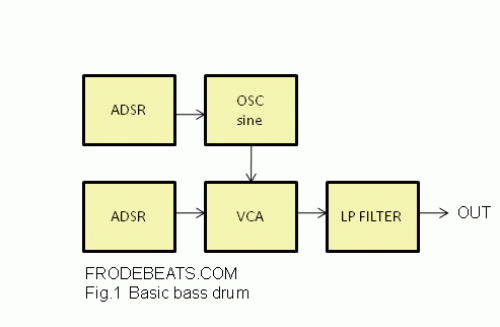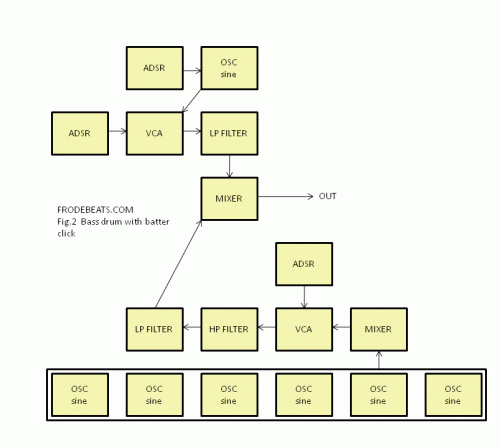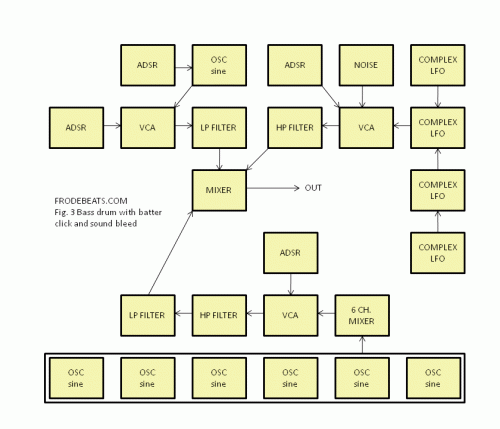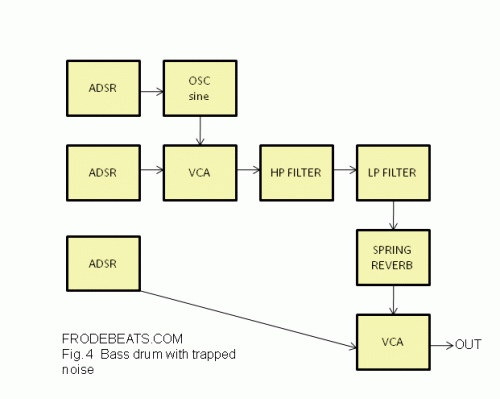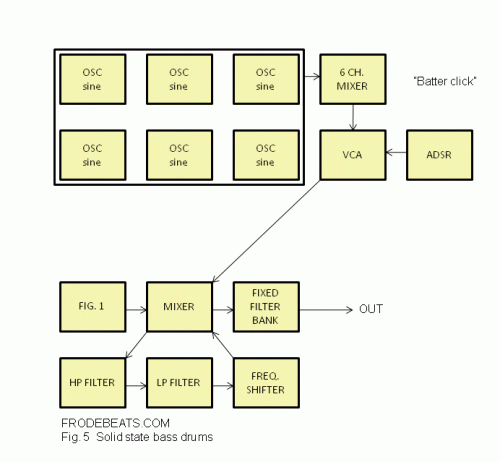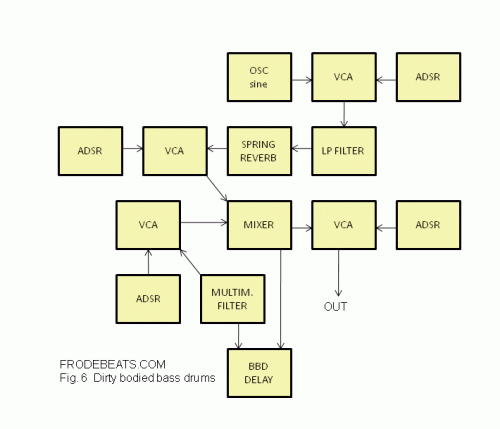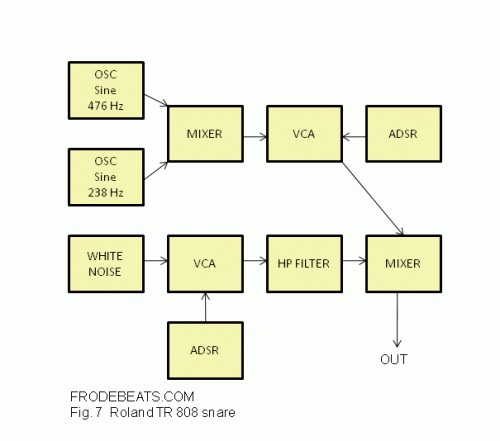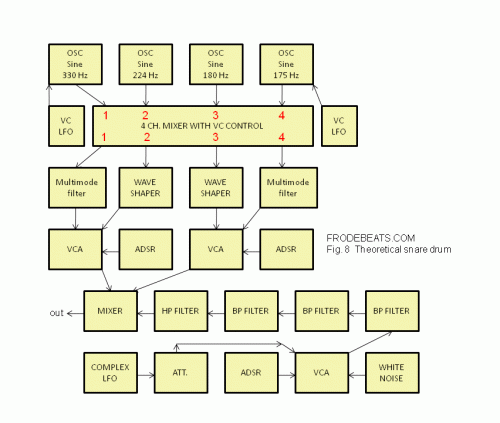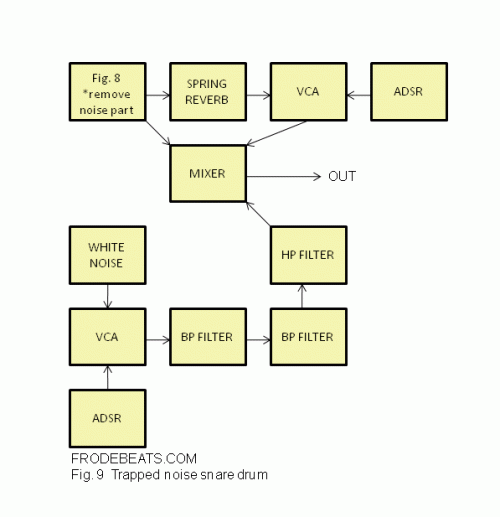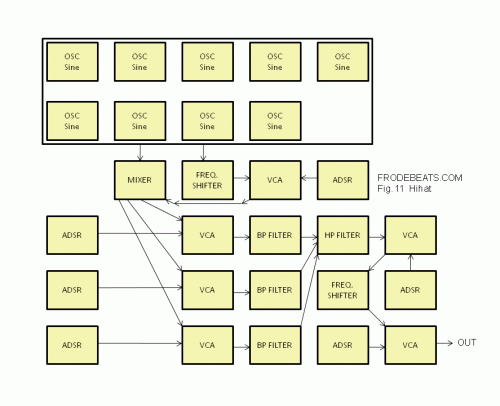Sound innovation and virtual instruments
Frodebeats article on examinating the concept of acoustic modelling of the drum set on modular synthesizer. Focus is on bass drums and snares, but it also brief examines high pitched percussion. Main focus is on the practical side of patching and only briefly discusses theory. PDF version here.
Standard modules have been used staying clear of the multipurpose modules to have better control of what is going on and at the same time obtaining a better understanding of the building blocks that make up the sound. Special modules include the BBD delay (Analog delay based on the bucket brigade chip), frequency shifter (Translates every signal feed into it by the same amount of Hz. If you have a 500 + a 1500 HZ sinus wave, you get at – 250 HZ, 250 and 1250 HZ), Wave shapers (offset, clipping, overdrive; basically anything that mangles sound).
This little arrangement produces a simple bass drum. Very electronic sounding and static in nature. From fig. 1 you can obtain the typical Roland 808 and 909 sound. Although the Roland 909 uses far more modules, you get pretty close. Although, this simple drum works great, what you get with this patch is actually only the body of the bass drum. What about this:
This adds a lot of useful features. For the attack, 6 oscillators tuned differently makes the batter click (For this you can also use noise, but i got better results using oscillators). The tuning of the oscillators is critical, best results are obtained when the oscillators are tuned enharmonically. Experiment with different settings to get the best result. Frequency shifter can also be applied. The batter click brings the drum “more forward”. Instead of just being a “thud” we now added more life into it cause we gave the drum some much needed mid frequency action. Apply different ADSR and filter settings to obtain a wide selection of timbres from the typical dance/trance drum to old analogue drum box sounds. You can stretch the duration of the batter click pretty far, thus making it less like a batter click and more like the mid frequency content of the drum. There is a huge variety of dance/techno drums to get from experiments with duration and filter settings on the “batter click”. But we need something better:
Fig. 3 takes us towards the world of acoustic modelling. A bass drum is a membranophone and this suggests many, many problems. With a bass drum you must consider the following: Trapped noise/ambience, the shell, pieces of metal on the shell, vibrations of the membrane, cavity/resonant modes and even sound bleed from the rest drum set and environment. I will discuss the factors that have given me the best results. When adding LP/HP filtered noise, giving it random volume at each attack, the bass drum comes more to life. The noise is simulating a snare drum leaking into the microphone and it gives the bass drum much needed mid frequency timbre, but it also has the bonus that each bass drum hit sound slightly different than the other, making this a more lively bass drum. You couls also apply a frequency shifter to the initial sinus wave to get subtle variations in drum pitch. This would simulate how a real drum acts, but i`ve found this to be not so critical (more important with the snare drum).
Building on this, we get Fig. 4:
The real problem with membranes is the membranes itself. Bass drums use 2 membranes, but in today’s music it`s more common to cut hole in the back, stuffing the drum with pillows or other damping materials. This makes things easier for us because membranes resonate, brings to life all kinds of harmonics, is never static and generally behaves like idiots. You can try to simulate this by applying oscillators/frequency shifters to mimic the different modes, but doing so actually produces not so satisfying results. The reason for this may be that our ear is accustomed and tuned to higher pitched sounds. When dealing with snare drums this become much more important (More on this later). I feel we can cheat to get a good result.
Fig. 4 was arrived at just experimenting and messing about, and it sounds good on itself, but for a more complex drum try this: Into Fig. 3, incorporate Fig 4. Patch main output of Fig. 4 into the main mixer in fig. 3. To get a degree of uncertainty in the bass drum body, use the same sine wave used for the body of the bass drum in fig. 3. Make sure the attack going into the spring reverb is rather slow or else you will end up with an overwhelming batter click. Experiment with the HP/LP settings and enveloped spring reverb; mix the trapped noise at different volumes together with the rest of the bass drum.
By this stage the bass drum patch is rather big. I know. But considering what is going on in a bass drum, we have dispensed a lot of factors.
Fig. 5 shows another approach. Many kinds of drum sounds are used in today’s commercial music. From the typical T-bridged 808 type sound to layered bass drums and acoustic drums. The main factor in the type of acoustic bass drums used is that they are often highly compressed. So much that you can almost hear the drummer breathing whilst drumming. Simulating the compressed bass drum can be difficult because usually there is not much information in the electronic drum to begin with. In hip hop the common thing is to layer different bass drums to obtain a massive sound, mixing real life recordings with electronic ones. Sounds from electronic instruments is in a way compressed to begin with, so if you compress, say, a 909ish bass drum, all you do is basically alter the ADSR stage and bringing in more ground noise (witch can be a good thing if this is the type of sound your after).
If you want to experiment with “compressed type” bass drums I have good experiences with recording the bass drum step by step with a lot of “uncertainty” elements. It`s time consuming but makes for very lifelike results. The principle is that you make use of the whole modular to make each element in the sound. No need to do it this way if you have 40-50 oscillators/ADSR/Filters/LFO/VCA`s, but I have yet to see a modular like that. Model everything from batter click, 2 membranes, trapped noise, small bits of cymbals and snare, etc. But make sure everything is volume modulated. This way you get much needed variation in each hit. Record every part of the bass drum sound and mix it together. The end result is a very complex, compressor friendly bass drum.
A simpler solution is the solid state bass drum in Fig. 5. I like to think of it as a drum that works great on radio (with a pleasant and rich mid freq content). Make the batter click rather high pitched, like a mid frequency hihat. Distribute the bass drum body (fig 1) + the batter click into a frequency shifter. Experiment with mid frequency content using the feedback amount on the frequency shifter. Drive the freq, shifter in mid frequency, filter out the high pitched/very low content. Doing so you can obtain bass drums with a pleasant long sustain (like Bjørk use on the homogenic album) and portishead-ish bass drums. The frequency shifter is a unique, often misunderstood module. Not so common in a modular setup, but for percussion sounds it`s really useful for obtaining even more content in a sound. The principle is getting as much information into the sound as possible, automating as much mid. freq. content as your modular allows, making the sound complex and evolving. Slap a good compressor on the end result and you may (or may not) end up with a slamming result. Of course it all depends on what is hidden in the sound you`ve created.
Adding a fixed filter bank at the main output gives a greater variety of solid state bass drums.
Fig. 6 produces, lifelike and unusual, good sounding bass drums. Using a spring reverb and a BBD delay in the sound path, the model builds on past experiments in acoustic modelling of strings and brass instruments. It may look like a simple model up to no good, but you`ll be surprised what it can do. Both the BBD and the spring reverb mimic the behaviour of membranes well. It also does a great job in recreating the chaotic behaviour of air pressure inside a bass drum. Experiment with the feedback settings on the BBD to obtain different timbres. Each hit also feeds back to the BBD itself. This has many advantages, amongst others to make each hit individual and lively. So even when dispensing with batter click and sound bleed you can still emulate a bass drum very well and lifelike.
To this model you could even split up the sine wave in two and patch it to a ring modulator, apply DC offset or clipping/rectifying on one input to obtain even more timbres.
Snare drums share much of the characteristics with bass drums, it has all the same modes, but obviously at a higher pitch. It`s two drum skins tuned differently, the shell, metal rib, trapped air, etc. If this is not troublesome enough we encounter another problem. The sound is highly attuned to our normal hearing range, so we are very able to distinct a real snare drum from an electronic one. You`ll never be fooled into believing the Roland TR 808 or 909 is a real snare drum. Let`s have a look at:
The world’s most popular snare sound? Used by so many artists for so many years it`s almost ridiculous. I wonder if Ikutaro Kakehashi, founder of the Roland Corporation envisioned just how popular the big black box would become. It`s a nice sounding, distinct snare that seem to cut through anything. Put this way back in the mix of a Norwegian death metal band and it will surly dominate the track. Almost. But you will never mistake it for a real drum. It`s electronic sounding. Looking at fig 7, it`s easy to understand why. It`s just too much information missing, especially mid frequency and low frequency content, it`s to static and the high frequency content are way to sterile.
So just to make it ugly:
... Makes you jump for the sampler. This model takes most of the snare drum modes into account. You have the ability to alter pitch and individual volume of the oscillators and noise. This is crucial to not making the snare static and lifeless, because every drum hit in the real world is different than the other. The ADSR control of white noise and ADSR control of oscillators is also vital. Make good use of the right sustain settings, experiment with settings of around 2/3/4 on noise and some of the oscillators to get different timbres at each hit. With careful use of VC control you get scary close to the real thing. With wave shapers on two oscillators you get a huge verity of timbres. The reason for two oscillators going into 12 DB HP filters is the ability to add resonance to the sine wave, doing so you get a more lifelike “spring” in the membranes. The BP filters are connected in parallel. This is a fantastic model, but it`s fragile. A single setting in volume or ADSR ruins it completely.
Work at it delicately and it will reap great rewards.
One thing missing from the theoretical model is ambience and sound bleed. My experience is that this is not very important on snare drums. It`s not like the bass drum will leak into the microphone when recording the snare. The hihat`s will to some extent do so, but not much. But what if we remove the spring? Now you left with the membranes, the wooden case, the metal on the wooden case and sound bleed. Removing the spring element basically make hell freeze over. I have yet to come up with a model that sounds anywhere near convincing. But add the trapped spring noise element to Fig 8 brings you near the ballpark. Important factor is bringing the noise very close to zero. It`s still there, but is removed from the membrane. Careful reverb settings bring the illusion of the wooden case. When making this type of drum it`s more important than before that the membranes are resonating. Driving all the oscillators close to self oscillation via the filter is beneficially. If done correctly you get a lot of uncertain elements that benefits the sound.
BBD SNARE DRUM
I`ve used the model from Fig 6 (using BBD) on snare drums with good results, following the theory of acoustic modelling, using 1, even 2 delays in the sound path (with or without oscillators as sound source). But in the end I found that working with Fig. 9 produces best result. That may well be because of the complexity of working with multiple BBD`s in an already extensive patch.
A totally different approach and nothing to do with the real world, but a good starting point for a great number of snare drum sounds.
Sometimes it`s a wise move to throw theory out the window and just go for it. The frequency shifters feedback and frequency settings alter the snare sound considerably. With this model I`ve stumbled upon a great number of “famous” snare drum sounds and to my surprise, even some very lifelike and hard hitting ones. It`s a lot of oscillators, but it`s necessary to get a full sound.
Hihats are for a number of reasons impossible to analyze. The way the vibrations manifest on the metal plate is so complex that we have yet to come up with a theoretical model that explains this in detail. If we should compare fig 11 to real life cymbals, it`s to say the least, a million times more static and lifeless. It works surprisingly well on closed hihats/ride, but the problem really kicks in at open hihats. Maybe why closed hihats work with this model is that our ears don`t have enough time realising it`s a fake, it`s all over to quick. For this patch, use as many oscillators you have available (6 should be the bare minimum) and send it through 3 different BP filters to obtain mid/high-mid/high frequency with different duration. With a frequency shifter with added feedback in the sound path you`ll get a thicker, fuller sound. The reason for all the VCA`s in the path is to prevent sound leaking from the oscillators due to the low volume and high ground noise when driving the filters upwards in frequency. Make sure the ADSR release times mimic how sound travels in the real world. Low pitched sounds travel “longer” and have a stronger signal, high frequency fades more quickly. But. It all depends on the environment. In my experience, hihats sound better the other way around with a slight longer decay/release of high frequency content.
But that`s just my personal taste. Making use of yet another frequency shifter at the last stage of the signal is ideal for more electronic and unusual sounding hihats.
I`ve nearly abandoned getting this sounding right. I`m using the same model, but either way it just do not sound right. More experimentation will be done in this area using acoustic modelling. A more logical approach to this could be the use of BBD delay`s cleverly patched up in feedback loops.
Coins, rattles, rim-shots, finger snaps, mouth percussion, handclaps, and all kind of thinkable and unthinkable percussion can be obtained using this model. The key is the gate delay and settings of the BP filters. It`s a really flexible model using all kinds of modules as wave shapers. I`ve tried frequency shifters, ring mod, overdrive, pedals, clippers and rectifiers with great success.
Worth mentioning is that layering coins, rattles, handclaps, etc, with snare drums often is the key for obtaining many of the popular snare drums used today. Producers seldom use a single snare drum in isolation. To get that really punchy sound in electronic drums layering is often the key, rather than just using compression

